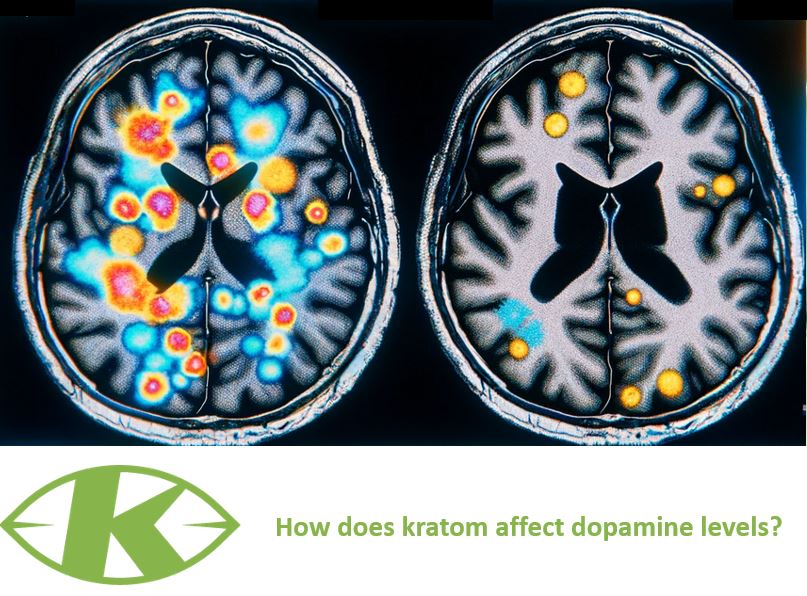
How does kratom affect dopamine levels?
Kratom affects dopamine levels by altering the reuptake process. In individuals with kratom addiction, there is less dopamine reuptake compared to those without a substance use disorder. According to study by Zainudin N, Zulkifli N, Abdul Hamid K, et al. (August 10, 2023) A Pilot Study of the Striatal Dopamine Transporter, the reduction in dopamine reuptake results in higher levels of dopamine in the brain, which may contribute to kratom's addictive properties and its impact on the dopamine-driven reward system.
The study test subjects demographic data below:
| Kratom-dependent mean (SD) | Healthy control mean (SD) | p-value | |
| Gender (male) | 12 | 13 | |
| Age, mean ± SD, years | 31.58 (11.28) | 32.23 (6.96) | 0.862 |
| Body mass index (kg/m2), mean ± SD | 24.56 (7.71) | 26.81 (5.70) | |
| Kratom abuse variable | |||
| Age of first use (years) | 21.83 (7.65) | - | |
| Duration of kratom used (years) | 9.92 (6.54) | ||
| Quantity of use (L/day) | 2.13 (1.68) | - | |
| Smoking variables, n (%) | 12 | 1 | |
| Activity injected (MBq) | 905.11 (74.13) | 922.32 (55.12) | 0.532 |
Does kratom dependency affect dopamine transporter (DAT) levels in the brain?
The study demonstrates that kratom dependency does affect DAT levels in the brain. It showed that kratom-dependent subjects had a reduction in the average standardized uptake value (SUV) in the left caudate and left striatum regions compared to healthy controls. This indicates a decrease in DAT levels, suggesting that chronic kratom use impacts the brain's dopamine system.
Are there differences in DAT levels between kratom-dependent individuals and healthy controls?
Yes, the study found significant differences in DAT levels between kratom-dependent individuals and healthy controls. Particularly, it observed a reduction in DAT activity in the left caudate and left striatum regions of kratom-dependent subjects. Additionally, the asymmetrical index percentage (AI%) in the caudate region was significantly different between the two groups, indicating alterations in DAT distribution due to kratom dependency.
How does chronic kratom use impact the brain's dopaminergic system?
Chronic kratom use appears to impair the brain's dopaminergic system. The study highlights a reduction in 99mTc-TRODAT-1 uptake in the striatum region of kratom-dependent subjects, suggesting decreased dopamine transporter activity. This reduction in DAT activity, especially with prolonged kratom use, indicates that chronic exposure to kratom can lead to changes in the brain's dopamine system, potentially similar to those observed with other substances of abuse.
Is there a correlation between the duration of kratom use and changes in the dopamine system?
The study suggests a correlation between the duration of kratom use and changes in the dopamine system. It was observed that the longer the duration of kratom intake, the more pronounced was the decrease in the mean SUV in kratom-dependent subjects. This trend indicates that prolonged kratom use is associated with progressive alterations in the dopamine system, specifically affecting dopamine transporter activity.
Does kratom addiction lead to similar DAT changes as seen with other opiate drugs?
The findings of the study suggest that kratom addiction may lead to changes in DAT similar to those observed with other opiate drugs. The reduction in DAT activity in kratom-dependent individuals mirrors the effects seen in dependencies on other opiates. This similarity underscores the potential impact of kratom on the brain's dopamine system, aligning it with the effects of other opiate drugs on dopamine transporters.
Can the effects of kratom on the dopamine system be quantitatively measured using 99mTc-TRODAT-1 SPECT-CT?
The study successfully demonstrates that the effects of kratom on the dopamine system can be quantitatively measured using 99mTc-TRODAT-1 SPECT-CT. This imaging technique was effective in identifying the changes in DAT activity, particularly in the striatum region of kratom-dependent individuals. The quantitative analysis provided clear evidence of the reduction in DAT activity, making 99mTc-TRODAT-1 SPECT-CT a valuable tool for assessing the neurobiological impact of kratom dependency.
To better understand regulatory insights, read the FDA's Kratom Assessment. For those exploring kratom’s effects on mood, check out our guide on achieving a Calm & Relaxed State.
Looking to try it yourself? Choose from our trusted products like Original OG Caps or the soothing Red Maeng Da Caps.
Sources
Sareen, A., & Rajkumar, R. P. (2023). A Pilot Study of the Striatal Dopamine Transporter Levels in Kratom-Dependent and Normal Subjects Using 99mTc-TRODAT-1 Single Photon Emission Computed Tomography-Computed Tomography (SPECT-CT). Journal of Addiction Medicine. Available at: https://www.cureus.com/articles/169450-a-pilot-study-of-the-striatal-dopamine-transporter-levels-in-kratom-dependent-and-normal-subjects-using-99mtc-trodat-1-single-photon-emission-computed-tomography-computed-tomography-spect-ct?score_article=true
Matsumoto, K., Mizowaki, M., Suchitra, T., Takayama, H., Sakai, S. I., Aimi, N., ... & Watanabe, H. (2021). Real time monitoring of dopamine release evoked by mitragynine. Neuropharmacology. Available at: https://www.sciencedirect.com/science/article/abs/pii/S002839082100246X
Swogger, M. T., & Walsh, Z. (2022). Kratom's rising role in the potential exacerbation of mental health. Journal of Substance Abuse Treatment. Available at: https://www.sciencedirect.com/science/article/pii/S2773021222000621
Prozialeck, W. C., & Avery, B. A. (2020). Kratom—Pharmacology, Clinical Implications, and Outlook: A Comprehensive Review. Journal of Psychoactive Drugs. Available at: https://pubmed.ncbi.nlm.nih.gov/32017685/
Grundmann, O. (2020). Focus: Plant-based Medicine and Pharmacology: The Potential for Kratom as an Antidepressant and Antipsychotic. Journal of the American Herbalists Guild. Available at: https://pubmed.ncbi.nlm.nih.gov/32017685/
Vijeepallam, K., Pandy, V. V., & Subramaniam, U. (2023). A Pilot Study of the Striatal Dopamine Transporter Levels in Kratom-Dependent and Normal Subjects Using 99mTc-TRODAT-1 Single Photon Emission Computed Tomography-Computed Tomography (SPECT-CT). Cureus. Available at: https://www.cureus.com/articles/169450-a-pilot-study-of-the-striatal-dopamine-transporter-levels-in-kratom-dependent-and-normal-subjects-using-99mtc-trodat-1-single-photon-emission-computed-tomography-computed-tomography-spect-ct?score_article=true
Veltri, C., & Grundmann, O. (2018). Kratom use and mental health: A systematic review. Drug and Alcohol Dependence. Available at: https://www.sciencedirect.com/science/article/abs/pii/S0376871618302229
Avery, B., & Grundmann, O. (2018). Kratom, an Emerging Drug of Abuse, Raises Prolactin and Causes a Hepatotoxic Effect in Rats. Journal of the American Herbalists Guild. Available at: https://journals.sagepub.com/doi/abs/10.1177/2156587218768225

